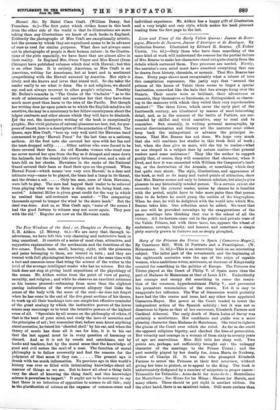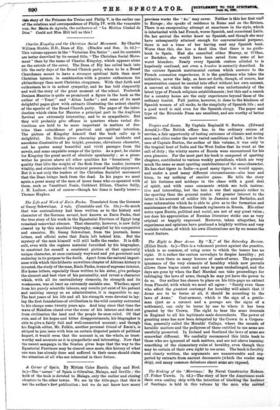Story of the Princess des UMW in. Spain ( Casnarera-Mayor)..
By Constance Hill. With 12 Portraits and a Frontispiece. (W. Heinemann. 7s. 6d.)—This is an interesting book on an interesting subject. The latter part of the seventeenth and the beginning of the eighteenth centuries were the age of the reign of capable women, when ambitious wives, mistresses, or duennas of Kings really counted for something in the politics of Europe. The Princess des Ursins played at the Court of Philip V. of Spain more than the part of Madame de Maintenon at that of Louis XIV. Undoubtedly her courage and energy did something to rouse the resolu- tion of the sensuous, hypochondriacal Philip V., and prevented his premature renunciation of the crown. Yet it is easy to exaggerate her influence. The War of 'Succession would probably have had the like course and issue, had any other been appointed Camarera-Mayor. Her power at the Court tended to lower the independent action of the Spanish nobility ; but it was not so disastrous to Spain as that of her successors, Elizabeth Farnese and Cardinal Alberoni. The early death of Maria Luisa of Savoy was certainly a misfortune. Her confidante and guide was a more pleasing character than Madame de Maintenon. She tried to lighten the gloom of the Court over which she ruled. As far as she could she opposed religions bigotry, and checked the fires of persecution. Her vivacity and courage in a woman of from sixty to seventy years of age are marvellous. Miss Hill tells her story well. Two points are, perhaps, not sufficiently brought out : the unhappy character of the marriage to the Prince 1Jrsini ; and the part secretly played by her deadly foe, Anna Maria de Neuburg, widow of Charles II. It was she who prompted Elizabeth Farnese to arrest the Princess at their first interview, without giving her time to protest, or to appeal to the King. The book is unfortunately disfigured by a number of misprints in proper names : Trimonille for Tremoille ; Auto-da-fd for Auto-de-fe ; Monteillano for Montellano ; Dna Minas for las Minas ; Marson for Mersin, and many others. These should be put right in another edition. On the other hand, there is an excellent index. Still more curious than
this story of the Princess des Ursins and Philip V. is the earlier one of the relations and correspondence of Philip IV. with the venerable nun, Sor Maria de Agreda, the authoress of "La Mistica Ciudad de Dios." Could not Miss Hill tell us this ?



















































 Previous page
Previous page